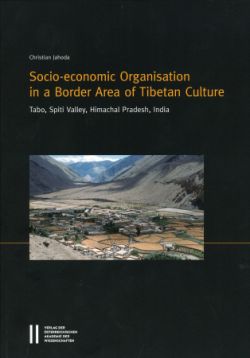
In dieser Arbeit wird zum ersten Mal die Entwicklung der Gesellschaft in Spiti und im oberen Kinnaur (Himachal Pradesh, Indien) über einen langen Zeitraum rekonstruiert, und zwar anhand einer ihrer zentralen Strukturen, der sozio-ökonomischen Organisation. Im Mittelpunkt dieser Studie steht die Untersuchung des Dorfes Tabo im Spitital und der umliegenden tibetischsprachigen Gebiete im nordwestlichen Himalaya. In methodologischer Hinsicht handelt es sich um eine Kombination von sozialanthropologischer Forschung und der Auswertung von historischen und rezenten Schriftquellen (teils aus dem Bestand des über 1000-jährigen buddhistischen Klosters in Tabo). Die im Kern auf Modellen der peasant theory aufbauenden theoretischen Konzepte und Perspektiven der Arbeit werden – durch die Einbeziehung von Erkenntnissen der sozialanthropologischen Tibetforschung zur gesellschaftlichen Strukturierung durch religiöse Institutionen wie buddhistische Klöster und Tempel – wesentlich weiterentwickelt. Die Darstellung der Ethnographie des Untersuchungsgebiets bildet zusammen mit der Untersuchung des Landrechts, in Verbindung mit dem Steuer- und Abgabensystem, einen zentralen Bestandteil in der Analyse der historischen und gegenwärtigen Beziehungen zwischen den jeweiligen Machthabern und den landwirtschaftlichen Produzenten (peasants). In diesem Zusammenhang ist auch die hier erstmalig erschlossene politische Geschichte der Region essentiell. In insgesamt zwölf Exkursen werden außerdem detailliert einzelne Schwerpunktthemen (wie z. B. Steuer- und Verwaltungswesen, unfreie Arbeit, regionaler, supra- und transnationaler Wollhandel, Ökonomie von buddhistischen Klöstern, Entwicklung der Bevölkerungszahl) in einem betont vergleichenden Fokus untersucht.
This study reconstructs for the first time the development of society in Spiti and in Upper Kinnaur (Himachal Pradesh, India) over a long historical period on the basis of one of its central structures, that is, socio-economic organisation. The focus of this study is the peasantry of Tabo village in Spiti Valley and the adjacent Tibetan-speaking areas in the northwestern Himalayas. From a methodological perspective this book is primarily the result of a combination of social anthropological fieldwork and the analysis of historical and contemporary written sources (partly from the holdings of the over 1,000-year-old Buddhist monastery of Tabo). The theoretical concepts and perspectives of this work, building at the core on peasant theory models, are considerably developed further by including and integrating findings from social anthropological research on Tibet, in particular the fundamental importance of religious institutions such as Buddhist monasteries and temples for the structuring of the social order. The account of the ethnography of the region forms together with the investigation of the system of land ownership in association with the system of taxes and dues a central component of the analysis of the historical and current relations between the power-holders and the agricultural producers (peasants). It is also in this context that the delineation of the political history of the region which is undertaken here for the first time plays an essential role. Moreover, in altogether 12 excursuses selected key topics (such as administrative and taxation system, corvée labour, regional, supraregional and transnational wool trade, economy of Buddhist monastic communities and monasteries, development of population figures) are studied from a strong comparative perspective.
2015,
978-3-7001-7816-3
978-3-7001-7913-9
367 Seiten davon 42 Seiten Farbbildteil, 1 Faltplan,
29,5x21cm, broschiert